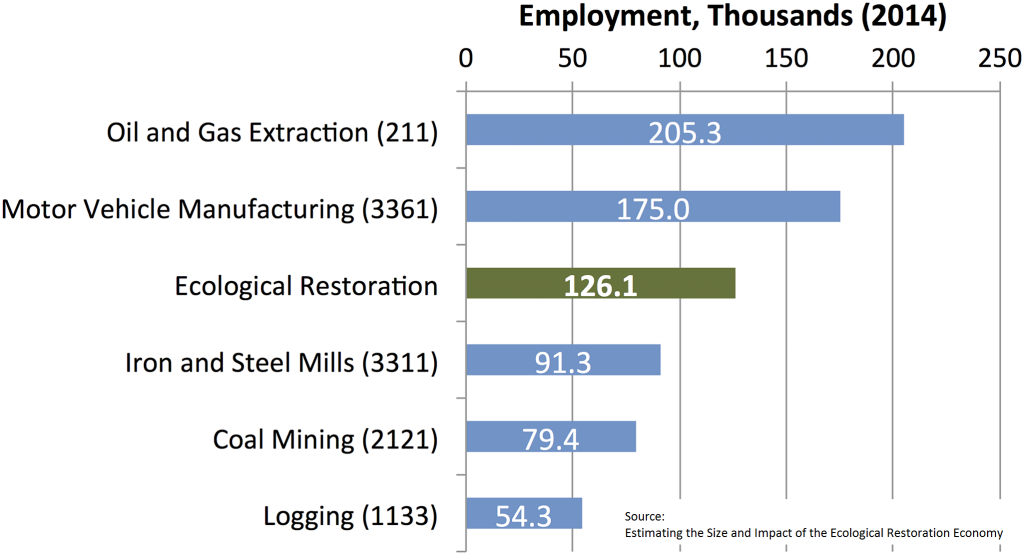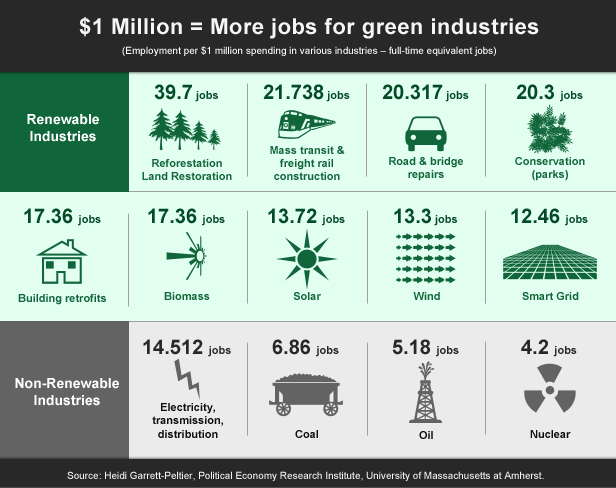Environmental Rollback Could Kill 220,000 Jobs And Eradicate Dozens of Species
President Donald Trump and many Congressional Republicans say they’ll create jobs by rolling back environmental regulation, but their current trajectory could have the opposite effect: killing more than 220,000 jobs while eradicating endangered species, poisoning water, and accelerating climate change. There is, however, a proven way to reduce regulations without hurting jobs or the environment.

6 February 2017 | US President Donald Trump has vowed to revive rural America by eliminating what he claims are burdensome environmental regulations. Towards that end, he’s stifling efforts to slow climate change, weakening environmental reviews to “expedite” infrastructure projects, and preparing to torpedo a 2015 rule protecting tributaries that provide one-third of our drinking water.
His pick to run the Environmental Protection Agency, Scott Pruitt, is expected to neuter the EPA rather than kill it outright, but Congressional Republicans aren’t being so subtle: Senator James Inhofe is still fighting the good fight against climate science, ostensibly to revive coal country, while Representative Rob Bishop has vowed to chloroform the Endangered Species Act, ostensibly to help western ranchers and oilmen. Last week House Republicans voted to let coal mines dump their debris into rivers and streams.
All these efforts might boost profits for some of the energy and agriculture interests that support Republicans on the House Resources Committee, but they probably won’t create more jobs than they destroy.
That’s because profits aren’t jobs. In fact, they’re often the opposite: companies save money by cutting jobs.
Now, cutting jobs can sometimes benefit the economy if those jobs aren’t adding value, but the jobs in question do add value by planting trees, restoring rivers, and turning soggy, unproductive farms into wetlands that filter water, purify air, and slow climate change – jobs that exist because companies that damage our environment have a responsibility to make us whole.
“Companies that don’t pay are guilty of theft,” says University of Chicago Professor Steve Cicala. “If someone has a better way of describing [the act of] taking something from someone without their consent and without compensating them, I’d be happy to use that term.”
Those jobs are part of a $25 billion “restoration economy” that directly employs 126,000 people and supports 95,000 other jobs – mostly in small businesses – according to a 2015 survey that environmental economist Todd BenDor conducted through the University of North Carolina at Chapel Hill.
That’s more jobs than logging, more than coal mining, and more than iron and steel, as you can see here:
The restoration economy is already providing jobs for loggers across Oregon, and even some coal miners in Virginia, but it could disappear if the GOP environmental rollback continues. Here are 11 things you need to know to understand it.
1. It’s not Solar and Wind
The restoration economy is not to be confused with the renewable energy boom that employs 374,000 people in solar parks and 101,738 on wind farms. Like those, however, the restoration economy is part of a burgeoning “green economy” that’s transforming forests, farms, and fields around the world.
2. It’s Government-Driven
State and federal governments helped the wind and solar sectors get off the ground, but both of those sectors are humming along on their own now because they provide a cost-effective way to produce electricity, which everyone needs.
The demand for restoration, however, isn’t as automatic as the demand for electricity is, because most companies and even some landowners won’t clean up their messes without an incentive to do so.
Economists call these messes “externalities” because they dump an internal responsibility on the external world, and governments are created in part to deal with them – mostly through “command-and-control” regulation, but also through systems that let polluters either fix their messes or create something as good or better than what they destroy.
Under the Endangered Species Act, for example, a local government that wants to build a road through sensitive habitat can petition the Fish and Wildlife Service for permission to do so. If permission is granted, it still has to make good by restoring degraded habitat in the same region.
3. It’s Often Market-Based
Pioneered in the 1960s, environmental markets offer flexibility in meeting commitments. That local government mentioned above, for example, can either restore the land itself, or it can turn to a “conservation bank”.
These are usually created by green entrepreneurs who identify marginal land and restore it to a stable state that performs ecosystem services like flood control or water purification. They make money by selling credits to entities – personal, public, or private – that need to offset their environmental impacts on species, wetlands or streams.
At least $2.8 billion per year flows through ecosystem markets in the United States, according to Ecosystem Marketplace research.
4. Infrastructure Also Drives Restoration
The federal government – especially the military – holds itself to high environmental standards, as do many states. Government activities alone support thousands of restoration jobs.
Government agencies are big buyers of credits, often to offset damage caused by infrastructure projects, but the link between infrastructure and restoration goes even deeper than that. In Philadelphia, for example, restoration workers are using water fees to restore degraded forests and fields as part of a plan to better manage storm runoff. In California, meadows and streams that control floods are legally treated as green infrastructure, to be funded from that pot of money. “Green infrastructure”, it turns out, is prettier than concrete and lasts longer to boot.
Trump wants to “expedite” infrastructure roll-outs, and he can do so without weakening environmental provisions by removing unnecessary delays in the permitting process (see point 11, below).
5. Markets Can Reduce Regulations
Nature is complex, and rigid regulations often fail to address that complexity, as environmental economist Todd BenDor makes clear when he points to regulations requiring the placement of silt fences in new subdivisions along waterways.
“They’re supposed to prevent erosion, but they often fail or are put in the wrong places,” he says. “Markets can simply enact a limit on erosion, allowing the landowner the freedom to be creative and efficient in any way they see fit in order to meet that limit.”
Done right, environmental markets can replace overly prescriptive regulations, but they still require government oversight and regulation.
“Markets are entirely reliant on strong monitoring, verification, and enforcement of limits,” says BenDor. “Provisions must be made to ensure that, but in reality it’s often a problem.”
6. Restoration Stimulates Rural Economies
In 2015, BenDor published a study called “Estimating the Size and Impact of the Ecological Restoration Economy”, which found restoration businesses in all 50 states. California had the most, but four “Red” states filled out the top five: Virginia, Florida, Texas, and North Carolina. Last place went to North Dakota.
By their very nature, restoration projects are located in rural areas, and a study by Cathy Kellon and Taylor Hesselgrave of EcoTrust found that Oregon alone had more than 7,000 watershed restoration projects, which generated nearly 6,500 jobs from 2001 through 2010. Many of those jobs went to unemployed loggers.
“The jobs created by restoration activities are located mostly in rural areas, in communities hard hit by the economic downturn,” report authors wrote. “Restoration also stimulates demand for the products and services of local businesses such as plant nurseries, heavy equipment companies, and rock and gravel companies.”
7. It’s been Mapped
Last year, the US Department of Agriculture’s Office of Environmental Markets, together with Ecosystem Marketplace publisher Forest Trends and the Environmental Protection Agency, published an online Atlas of Ecosystem Markets, which you can access here.
8. The Jobs are Robot-Proof
Environmental regulations didn’t kill coal; natural gas and renewables did. Regulations didn’t stifle the western oil boom, either; that was low energy prices. Even if Trump & Co do prop the coal sector, jobs won’t go to people; they’ll go to machines, which took most of the jobs America lost in the last decade.
BenDor’s research shows restoration jobs are evenly divided between white-collar planners, designers, and engineers and the green-collar guys doing the actual earth moving and site construction.
Almost all involve time in the great outdoors, and they can’t be exported or done by robots.
9. The Jobs are Cost-Effective
Because restoration work is labor-intensive, the money goes to people instead of machines, and every $1 million invested generates 33 jobs on average. Every $1 million invested in oil, on the other hand, generates 5.2 jobs per $1 million invested. In coal, the figure is 6.9 jobs.
10. It Doesn’t Stifle Business
Some industry groups claim the Endangered Species Act blocks development, but researchers reviewed 88,000 consultations between 2008 and 2015 and found that no projects had been stopped or even changed in a major way to protect habitat.
Even proponents of the system concede, however, that the permitting process is slow and tedious.
11. It Can Be Improved
While the FWS administers credits for mitigation of endangered species, the Army Corps of Engineers approves mitigation credits for streams and wetlands, and they’re notoriously underfunded. This leads to long and costly delays, according to unpublished research that BenDor conducted with Daniel Spethmann of Working Lands Investment Partners and David Urban of Ecosystem Investment Partners.
Delays are so costly, they argue, that companies in the restoration sector might be better off paying 50-fold higher permitting prices that would give the agencies the staff needed to properly process permits, akin to expedited building permits, rather than paying banks the interest on loans for land where environmental improvements are being held up.
Please see our Reprint Guidelines for details on republishing our articles.






SIR PLEASE GIVE ME A JOB ON YOUR CONCERN